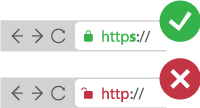The holiday season brings more than just festive cheer—it is also prime time for online shopping and tempting deals. Yet, amidst the hustle and bustle of virtual carts and checkout buttons, there’s a less cheerful reality: cyber criminals lurking in the digital shadows, eager to take advantage of the frenzy.
Especially during this busy time of the year, it is crucial to keep your guard up and prioritize online safety.
Before you settle in for some holiday shopping, let’s explore how to safeguard your digital transactions and keep cyber grinches at bay. Huge thanks to our friends at HSB: A Munich Re Company for preparing these practical cyber security tips to accompany you through your online shopping journey, ensuring the perfect gift remains secure and worry-free.
1
Use unique passwords
Use unique passwords for each of your online accounts and change them frequently. If it is difficult to come up with strong passwords, or to remember them, consider using a password manager tool that can organize, store, protect, and even generate your passwords across multiple devices.
2
Avoid creating a saved account – instead, opt to “Checkout as guest”
While it may not feel the most convenient, it ensures your personal information remains secure.
If you do open a website account to get the deal/coupon/discount, either delete the account ASAP or do a year-end purge and unsubscribe from websites.
3
Have a designated shopping email
Create an email solely for shopping and other “riskier” behavior so spam does not mix with legitimate communications.
4
Avoid public Wi-Fi
As convenient as public Wi-Fi is, resist the temptation to buy online in a public space unless using a Virtual Private Network (VPN) or secured Wi-Fi.
While connected via VPN, online transactions are shielded from view by hackers on the Wi-Fi network. A VPN typically requires a subscription and password but is worth the price tag if sharing personal information or making purchases over public Wi-Fi.
5
Pay attention
Think before you click!
By focusing on where and when you are online shopping, you avoid bogus sites and sketchy content.
If the deal sounds too good to be true, it just might be.
6
Verify the seller
When making a purchase, make sure to vet the reputation of the seller and the authenticity and security of the website. The higher the value, the more time you might want to spend researching.
A great way to start is by looking at reviews on sites like the Better Business Bureau, which makes it difficult for people to post phony reviews. Be wary of sites with only positive reviews, or reviews that are actually paid ads.
7
Resist “buy now” ads
Pause and review. Be mindful of online ads that prompt you to “buy now.”
Do not fall victim to mindlessly clicking and immediately purchasing because of the urgency and emotion the ad may provoke.
9
Understand your payment options
Use a payment processing tool like PayPal or a credit card, not a debit card or online check. And if you have several credit cards, use the one with the lowest limit.
If the website turns out to be fraudulent, or the item isn’t received, the credit card company will investigate and may cancel the charge or limit the cardholder’s liability for it.
10
Check your statements
After the shopping is over, make sure to check your credit card and banking statements. Confirm the purchases and look for unexpected charges.
If there is a fraudulent purchase, report it to the credit card company. They will investigate the incident and may issue you a new card, depending on the severity of the threat.
Content from this article was provided by Hartford Steam Boiler. © 2023 The Hartford Steam Boiler Inspection and Insurance Company.
All rights reserved.






